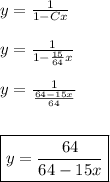Answers: (a)

, for any constant C
(b) Solution does not exist
(c)

(d)
 Explanations:
Explanations:
(a) To solve the differential equation in the problem, we need to manipulate the equation such that the expression that involves y is on the left side of the equation and the expression that involves x is on the right side equation.
Note that
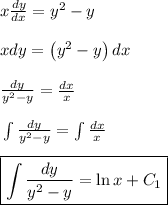
(1)
Now, we need to evaluate the indefinite integral on the left side of equation (1). Note that the denominator y² - y = y(y - 1). So, the denominator can be written as product of two polynomials. In this case, we can solve the indefinite integral using partial fractions.
Using partial fractions:
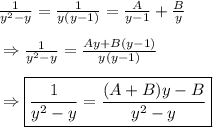
(2)
Since equation (2) has the same denominator, the numerator has to be equal. So,
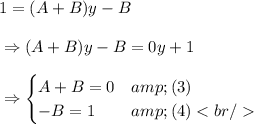
Based on equation (4),
B = -1. By replacing this value to equation (3), we have
A + B = 0
A + (-1) = 0
A
+ (-1) + 1 = 0 + 1
A = 1
Hence,

So,
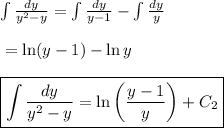
Now, equation (1) becomes
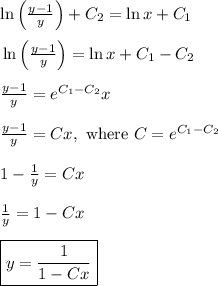
(5)
At point (0, 1), x = 0, y = 1. Replacing these values in (5), we have

Hence, for any constant C, the following solution will pass thru (0, 1):

(b) Using equation (5) in problem (a),

(6)
for any constant C.
Note that equation (6) is called the
general solution. So, we just replace values of x and y in the equation and solve for constant C.
At point (0,0), x = 0, y =0. Then, we replace these values in equation (6) so that

Note that 0 = 1 is
false. Hence, for any constant C, the solution that passes thru (0,0)
does not exist.
(c) We use equation (6) in problem (b) and because equation (6) is the general solution, we just need to plug in the value of x and y to the equation and solve for constant C.
At point (16, 16), x = 16, y = 16 and by replacing these values to the general solution, we have
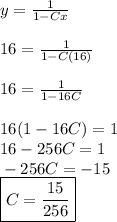
By replacing this value of C, the general solution becomes
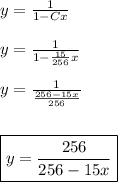
This solution passes thru (16,16).
(d) We do the following steps that we did in problem (c):
- Substitute the values of x and y to the general solution.
- Solve for constant C
At point (4, 16), x = 4, y = 16. First, we replace x and y using these values so that
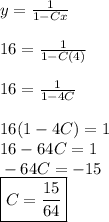
Now, we replace C using the derived value in the general solution. Then,
